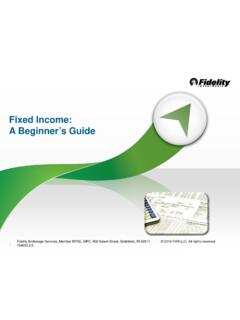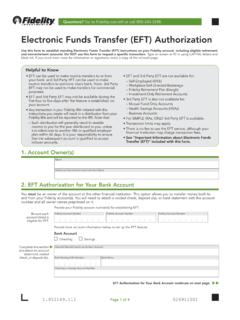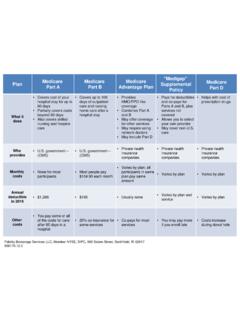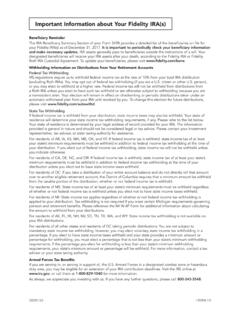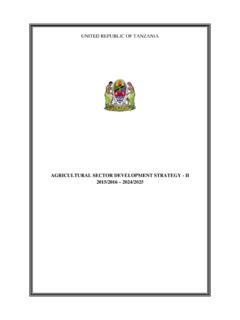Transcription of Investment Strategy
1 PInvestment StrategyInterpreting key concepts and choosing appropriate strategiesContents Asset Allocation 2 Strategic asset allocation 6 Tactical allocation 8 Choosing the appropriate mix 9 Portfolio rebalancing10 Disciplined investing13 Managing your portfolio Ta x Ef fic ie n c y14 Tax-efficient investing15 Asset location 16 Tax-loss harvesting17 Tax-smart Investment management1 Your Next Steps18 Put your strategies to work19 Important informationINVESTMENT STRATEGY1 Designing your specialized Investment strategyYour goals are as unique as you are.
2 That s why your personal Investment Strategy needs to reflect the following: Where you re headed How you plan to get there What your specific objectives are When you want to achieve them What level of risk you re willing to accept to reach your goals In this discussion guide, we ll take a look at how you can use several Investment strategies to serve your family s unique needs. The strategies are broken into two categories asset allocation and tax EfficiencyAsset AllocationAt Fidelity, we believe: Asset allocation is the single most important factor in assessing the long-term risk- and-return characteristics of a diversified portfolio.
3 Efficient portfolio diversification can be one way to lower a port-folio s risk while maintaining its expected Fidelity, we believe: Overlooking the potential impact taxes can have on Investment returns is one of the most common mistakes investors make. The type of account in which you hold certain assets can make a major difference in how much you can earn, after tax, over ReviewAt Fidelity, we believe:Investors should begin the portfolio review process by clearly defining their investing goals and time frame, then commit to periodic reviews of their STRATEGY2 Strategic asset allocationBuild a Strategy designed for your needs, and stay committed to it.
4 Asset allocation is the single most important factor in assessing the long-term risk-and-return characteristics of your portfolio. Research shows that the Strategy of selecting the percentage of stocks, bonds, and cash in a portfolio can be said to be responsible for more than 90% of the variability in portfolio asset allocation decisions can cause the returns of the average stock or bond investor to lag the respective markets. You should allocate your investments across stocks, bonds, and cash to help reduce portfolio risk, seek attractive returns, and avoid the pitfalls of market timing.
5 In addition, investors with longer time horizons have the capacity to accept a higher level of portfolio volatility associated with a more significant weighting in equities, which should include broadly diversified international funds to take advantage of diversification benefits outside the United your asset time horizon, current financial situation, and tolerance for market swings will influence how aggressively or conservatively you choose to invest. Investors can trail the market significantly. Decisions by investors to get in and out of the market or to select underperforming investments can cause them to generate far lower returns than the overall market.
6 UNDERSTAND YOUR RISK TOLERANCE LessAggressiveProfileMoreAggressiveProfi leTime HorizonShort-term goalNo emergency fundsDecreasing future incomeLarge amount of debtMarket changes cause anxietyLong-term goalAdequate emergency fundsIncreasing future incomeSmall amount of debtComfort with market changesCurrent Financial SituationRisk ToleranceASSET ALLOCATION Where do you fall on the spectrum of time horizon, current financial situation, and risk tolerance? How has your risk tolerance influenced your Investment decisions?QASSET ALLOCATION3 Consider portfolio diversification and select your target asset diversification is the mix of stocks, bonds, and cash held in a portfolio.
7 One way to help protect yourself from the unpredictability of the market may be to diversify your holdings across these three main types of investments. This approach can help lower the risks associated with having all your money in only one type of Investment . Your asset mix depends largely on your specific financial situation. Typically, a longer investing time frame allows for a higher percentage of stocks in your portfolio. If you are near retirement you may want to consider a gradual process of transitioning into a lower volatility asset mix.
8 Keep in mind that retirement for some investors could last 30 years or longer, so the growth potential of your portfolio should still be an important consideration when selecting your Investment :n Short-Termn Foreign Stocksn Domestic Stocks n BondsASSET ALLOCATION What has led you to arrive at your current asset mix?QTARGET ASSET MIXESS hort-TermConservativeModerate with IncomeModerateBalancedGrowth with IncomeGrowthAggressive GrowthMost AggressiveMay be appropriate for investors who: Seek to preserve capital Seek to minimize fluctuations in market values Seek income and the potential for capital appreciation, with a slight priority on income Seek income and the potential for capital appreciation.
9 With a slight priority on capital appreciation Seek potential for capital appreciation and some growth Seek moderate growth and income Have a preference for growth Seek aggressive growth Seek very aggressive growth Can accept the lowest returns in exchange for price stability Take an income-oriented approach with some potential for capital appreciation Can withstand moderate fluctuations in market values Can withstand moderate fluctuations in market values Can withstand moderate fluctuations in market value Can withstand moderate fluctuations in market values Can withstand significant fluctuations in market value Can tolerate wide fluctuations in market values, especially over the short term Can tolerate very wide fluctuations in market values.
10 Especially over the short term100%Short Term30%Short Term14% Stocks50%Bonds6%Int l Stocks10%Short TermShort TermAggressiveGrowthMostAggressiveConser vativeBalancedGrowth35% Stocks40%Bonds15%Int l Stocks5%Short Term49% Stocks25%Bonds21%Int l Stocks60% Stocks15%Bonds25%Int l Stocks70% Stocks30%Int l Stocks100%30%20%15%21%28%14%50%50%45%6%9 %12%10%35%40%15%5%49%25%21%60%15%70%30%2 5%5%42%35%18% Investment STRATEGY4 Consider your asset mix return and volatility , as a portfolio s stock exposure increases, the potential for both higher returns and larger losses also increases.




